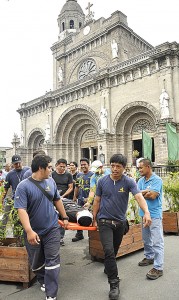Chairman Francis Tolentino of the Metropolitan Manila Development Authority (MMDA) gave Thursday’s massive earthquake drill a grade of 9 of 10 for ramping up public awareness on the need to prepare for disasters, but another official noticed one important detail that nearly all drill organizers missed--only a few participants had “go bags” with them.
Director Renato Solidum of the Philippine Institute of Volcanology and Seismology (Phivolcs) agreed with the MMDA chief that the level of awareness had improved but, he said, more needs to be done in making people really prepare for the so-called “Big One.”
done in making people really prepare for the so-called “Big One.”
“Many managed to evacuate the buildings they were in but most of them did not have emergency bags with them because in a real earthquake, they could not get back, there would be no food, and rescuers may not immediately get to them,” he told a TV interview on Friday.
The emergency bag or “go bag” or as what the Red Cross calls as a “lifeline kit” contains water and non-perishable food, utility tools, whistle, flashlight, transistor radio, clothes, toiletries and a first aid kit.
Thursday’s exercises simulated the effects of a massive magnitude 7.2 earthquake in Metro Manila, with an “initial damage assessment” conducted via aerial reconnaissance, using aircraft with data-link capability and motorcycle volunteers.
Afterward, the National Disaster Risk Reduction and Management Council (NDRRMC) activated its “National Response Clusters” involving the Department of Social Welfare and Development (DSWD) and the Armed Forces of the Philippines (AFP).
This involves the DSWD activating its “12-Response Clusters,” which direct the AFP to set up its Multi-National Coordination Center to request aid from allies of the country.
Muscle memory
Retired admiral Alexander Pama, NDRRMC executive director, said the primary goal of Thursday’s drill is to prevent panic, which could cause needless injuries and deaths should a magnitude 7.2 tremor hit Metro Manila anytime in the future.
He added that the development of “muscle memory” (instinctive reaction of what to do in an event of major quake) will help prevent panic and provide people with the readiness, skills and knowledge needed to survive a major tremor.
Pama said the drills provide responders with the opportunity to plan their response and determine their shortage of equipment and training.
Once the “duck, cover, and hold” mentality takes effect, the NDRRMC chief added, it is very probable that injuries and deaths that would result from a major earthquake will be greatly reduced.
Tolentino said the Metro Manila Disaster Risk and Reduction Management Council wants to institutionalize the exercise.
By making the drill regular, he added, all concerned agencies including local government units (LGUs) will have enough time to prepare for disasters.
“With the success of the first Metro-wide shake drill, I think this should be institutionalized,” Tolentino said. “So there will be a shake drill for 2016, 2017 and so on.”
“If it will be done regularly, then the people will expect it every year which will also increase their awareness and participation,” he added.
Sen. Loren Legarda reiterated her proposal to conduct monthly fire and earthquake drills and other disaster preparedness measures particularly in educational and healthcare institutions.
Legarda earlier filed Senate Bill 357, or the Preparedness in Buildings during Fire, Earthquake and other Hazardous Phenomena Act.
Under the bill, schools and other educational establishments, hospitals, nursing homes, clinics, orphanages and other buildings or structures used for the care of or occupied by the sick, infirm, or disabled are mandated to conduct monthly emergency drills.
The bill also proposes the conduct of emergency drills in school buses and other vehicles for transporting school children at least twice every school year.
With JEFFERSON ANTIPORDA, NEIL A. ALCOBER and PNA


